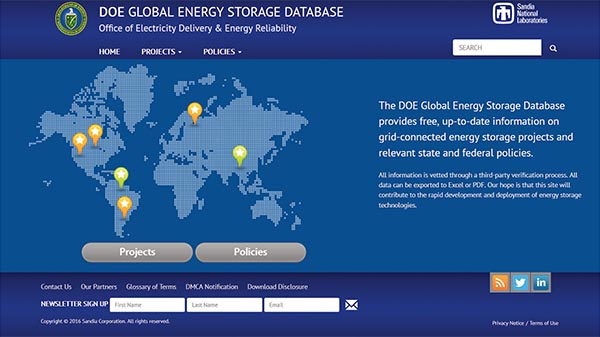Sandia builds global energy storage database

For more information about the Global Energy Storage Database, click on the image above.
Sandia engineers have teamed with experts at Strategen Consulting to create a database that provides free, up-to-date information about grid-connected energy storage projects in the US and worldwide.
The goal of the Global Energy Storage Database (GESD) is to encourage research, development, and deployment of energy storage technologies by providing a single platform where project information can be shared. It benefits energy storage systems users, researchers, and other stakeholders.
The GESD is a resource for power generators, utilities, and customers interested in adding energy storage to their systems to learn what storage technologies and rated power options are in use, what the primary use cases are for the grid, and how long each technology type can store energy.
“Energy storage is vital to grid resiliency and reliability during emergencies like power outages from natural disasters, equipment failure, accidents, or terrorist events,” says Sandia researcher and project lead Jaci Hernandez (6111).
The work is supported by DOE’s Energy Storage Program in the Office of Electricity Delivery and Energy Reliability.
Balancing power supply
In addition to providing backup power for emergencies, Jaci says energy storage can instantaneously balance power supply and demand and thereby facilitate expanded use of highly variable renewable resources like wind and solar on the grid.
“As we add more renewable energy capacity on the grid, we need energy storage to bridge the gaps between times when electricity is widely available and when it isn’t,” Jaci says.
The database describes 1,577 operational projects in 69 countries.
It provides information on 53 energy storage technologies divided into five categories: electro-chemical, electro-mechanical, hydrogen storage, pumped hydro storage, and thermal storage. Information about the amount of storage, how that storage is connected to the grid, who owns it, and how the storage is used is included for each location.
The policy section includes landmark decisions like Federal Energy Regulatory Commission orders and up-to-date DOE policy mandates that affect energy storage. GESD will eventually include current docket information for energy cases in state and regional regulatory bodies in the US and elsewhere.
“Energy storage systems owners and developers provide dynamic data to the database. That kind of detailed information is hard to find because not all storage owners share information about their systems widely,” Jaci says.
The database shows that the United States has the most energy storage capacity on its grid, followed by Spain, Germany, Japan, and China.
Jaci says the database will provide continually more accurate data that will improve user comparisons and analyses. To include smaller projects in the database, Sandia and Strategen Consulting are developing a way to include in GESD all energy storage projects greater than one megawatt that are currently part of the comprehensive data collection of the US Energy Information Agency.
Jaci says future GESD plans include more information about relevant energy policies, more technical data, a platform to share ESS codes and standards, improved data visualization, and an advisory board.